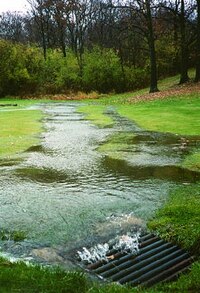
Photo from wikipedia
Abstract Spatio-temporal variation in rainfall-runoff erosivity resulting from changes in rainfall characteristics due to climate change has implications for soil and water conservation in developing countries. Understanding past and future… Click to show full abstract
Abstract Spatio-temporal variation in rainfall-runoff erosivity resulting from changes in rainfall characteristics due to climate change has implications for soil and water conservation in developing countries. Understanding past and future variations in rainfall-runoff erosivity and its implication, in tropical areas where there are limited continuous daily rainfall records, is important. The present study attempted to (i) quantify the nature of spatiotemporal variability of erosivity from rainfall amount using Global Circulation Models (GCMs), and (ii) evaluate the implications of changes in rainfall-runoff erosivity in the Lower Niger Basin, West Africa. The GCMs scenarios (GFDLCM3, HADCM2, MIROC5, and MPIESMLR) were statistically downscaled using the delta method for three-time slices (the 2030s, 2050s, and 2070s). World climate data was used as the current baseline climate since it is the source of the future precipitation simulation. The R factor from the Revised Soil Loss Equation (RUSLE) was used to determine erosivity, while the RUSLE model was used to ascertain the implications of changes in erosivity. Observation data (1970–2013) from 20 meteorological stations were used to validate the erosivity model. The result indicates that there is an increasing trend in the annual rainfall-runoff erosivity from the baseline climate up to the GCMs, for all the GCMs, with an average change in rainfall-runoff erosivity of about 14.1%, 19%, and 24.2% for the 2030s, 2050s, and 2070s respectively. There was a concomitant increase in soil loss of 12.2%, 19.3% and 20.6% from the baseline for the 2030s, 2050s, and 2070s respectively. Though the combined average annual rainfall and erosivity show steady increases, some of the models (GFDLCM3-2.6 and HADCM2-2.6) reveal a likely decrease in annual rainfall and erosivity for the 2070s. Higher precipitation amounts were the major drivers of increasing spatial and temporal rainfall-runoff erosivity. More studies should be performed to include other important factors that exacerbate increases in erosivity, especially future changes in land use.
Journal Title: CATENA
Year Published: 2019
Link to full text (if available)
Share on Social Media: Sign Up to like & get
recommendations!